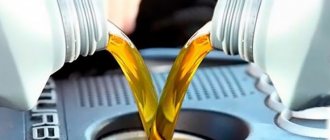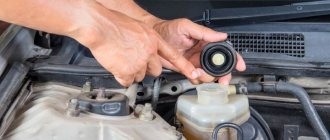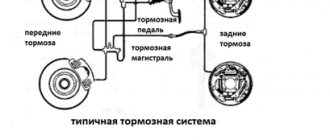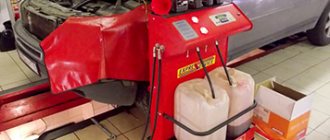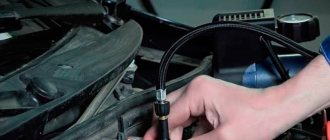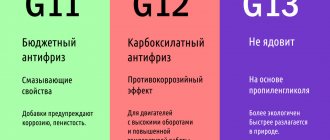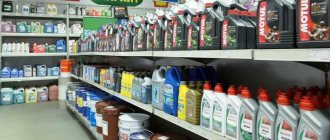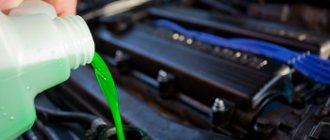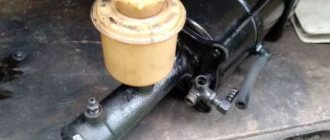Author: Evgeny Zhivoglyadov. Date of publication: May 01, 2016. Category: Automotive equipment.
Safe driving of a vehicle is impossible if its braking system is intermittent. This unit requires increased attention, since it is directly responsible for the safety of both passengers and the driver himself. In this regard, it is important to promptly replace brake fluid, which must be of proper quality and expiration date.
Today, car markets and specialized stores offer a wide selection of different brands of brake fluids. The most popular of them are Castrol and Mobil, but among the budget options there are decent compounds with excellent characteristics, for example: rosDOT or SuperDOT.
All “DOT” liquids are divided into several types: DOT 3, DOT 4 and DOT 5. Each of these compositions has its own characteristics and can only be used with certain types of machines. But, before we look at the composition of brake fluid DOT 4 and 3, it is worth saying a few words about the general characteristics of all fluids for the brake system of a car.
Technical characteristics of DOT 4
All brake fluids except DOT 5 (using silicone) are based on polyethylene glycols and polyesters of boric acid. The main physical and chemical characteristics of DOT 4 and other brake fluids that determine quality:
- viscosity;
- boiling temperature;
- anti-corrosion;
- hygroscopicity.
Minimum boiling point of brake fluid
Viscosity graph of TFA DOT-3, DOT-4, DOT-5 and DOT-5.1 depending on temperature
The viscosity of DOT-4 fluid fluid should be more than 750 mm2/s, but not more than 1800. It is responsible for the quality of brake performance. The lower the viscosity, the faster the braking force is transmitted.
According to standards, the boiling point of DOT 4 brake fluid is not lower than 250 °C (if new without moisture) and not lower than 165 degrees with the amount of moisture up to 3.5% (old, so-called wet fluid).
The anti-corrosion properties of brake fluid are associated with acidity, which should be pH 7.0 – 11.5. Protective properties against corrosion are provided by additional special additives.
The hygroscopicity by borates, which are used in the composition of the brake fluid; they are able to bind water molecules that come from the air during operation, but still, over time, moisture accumulates, because glycol brake fluids are hygroscopic.
Interchangeability of different brands
Recommendation one: topping up brake fluid made on a different base is unacceptable and dangerous to the lives of vehicle passengers. That is, silicone or BSA cannot be added to the glycol composition and vice versa.
What is the danger: the consequences do not appear immediately, but after some time, until the material is mixed and heated as a result of the brakes being applied. A precipitate forms in the mixture and dense clots form, blocking the normal operation of the system - the brakes fail. In the best case, you will have to empty all the cylinders and pipes for thorough washing.
Now about whether it is possible to add liquid made on the same basis. It is quite permissible to dilute the glycol composition with a similar material, but with reservations:
- It is allowed to mix glycol fluids DOT 3, 4 and 5.1 with each other, DOT 5 is a silicone material, it cannot be added.
- If you added a glycol composition with a lower boiling point, for example, DOT 3, to the fourth series fluid, the brake system is not in danger, but upon arrival at the garage it is recommended to change the working environment. The reason is the deterioration of the properties of the mixture due to the addition of low-grade material.
- After adding a higher class fluid, for example, the 5.1 series to the DOT 3 composition, the temperature characteristics of the mixture will improve. It is not necessary to completely change the fluid in the brake system, unless you notice suspicious deviations - pedal failures or a weak response to its pressing.
Advice. It is recommended to add brake fluid on the road only after eliminating a leak or problem causing loss of brake fluid. The exception is a minor leak, where liquid escapes in small quantities.
Like glycol, silicone compounds are also interchangeable because they are made on the same basis. The boiling point of DOT 5 and DOT 5.1/ABS is identical - 260 °C (wet material - 180 °C). There is a limitation here: it is highly undesirable to add Series 5 fluid to cars equipped with an ABS anti-lock braking system; only the “native” material is DOT 5.1/ABS.
If you find yourself in a hopeless situation and still fill the expansion tank of a car with ABS with Series 5 compound, empty the system as soon as possible when you get to a garage or car service center. The additive will not lead to an emergency and will not cause significant harm to the parts, but will shorten the service life of the rubber elements.
Differences between DOT-4 brake fluid and DOT 3, DOT 5 and DOT 5.1
the chemical base of brake fluids DOT 3, DOT 4 and DOT 5.1 , but still, the boiling point and moisture absorption due to additional additives and borates are different , so the properties, as well as their applicability, differ.
Main classification indicators of brake fluid
DOT 3 - this liquid is based on compounds of 2-atomic alcohols of glycols. That is why it is very hygroscopic, and also very aggressive to paint and rubber brake pads, which is not permissible in the brake systems of modern cars. So they try not to use such a liquid, and if they do pour it, it is only into old cars with drum or disc brakes (only on the front wheels), because its price is low and, for an economy version, it does its job well for a year and a half.
What you need to know about brake fluid?
DOT 5 is as close as possible to ideal parameters, since, due to the fact that it is based on silicones, it has both a high boiling point and low viscosity, has good lubricating properties, is neutral towards rubber and metals, and absorbs moisture from the environment very quickly. slowly. Such properties allow you to replace DOT class fluid 5 times every 5 years.
But not everything is as good as it may seem - with such excellent technical characteristics, DOT 5 fluid also has its drawback - it is not intended for use in cars with ABS systems. First, because silicone repels water and does not mix with the liquid, it can freeze at low temperatures. Secondly, it has a high degree of aeration (saturated with air).
Based on all the characteristics of other brake fluids, we see that DOT 4 fluid has the most optimal performance, which is why it is so popular and most used in standard-use vehicles.
Brake fluid color coding
Do brake fluids differ in color?
The FMVSS No. 116 DOT standard, as well as others developed later (SAE J 1703 and ISO 4925), require color coding of brake fluid according to the specific base, in order to exclude the possibility of mixing categorically incompatible fluids. But such a difference will not make it possible to determine what you have filled: DOT 3, DOT 4 or DOT 5.1, because such liquids will often have one color - amber-yellow, but silicone liquid of the DOT 5 class is usually painted pink.
In addition to the color, the bottle must contain the inscription “SILICONE BASE” (SBBF) for DOT-5 and “NON-SILICONE BASE” (NSBBF) on a bottle with liquid class DOT-5.1.
Purpose and properties of brake fluids
The purpose of brake fluid is obvious - to ensure inertia-free (almost instantaneous) transmission of force from the brake pedal to the brake mechanisms. This uses one of the main qualities of a liquid under normal environmental conditions: incompressibility.
However, operating conditions are often far from normal: intense braking in mountainous areas or with an aggressive driving style causes overheating and boiling of the brake fluid, and the appearance of gas bubbles in it. Gaseous inclusions impair incompressibility, leading to “sinking” of the brake pedal and actual failure of the brake system. Thus, the boiling point is perhaps the most important characteristic of brake fluid: the higher it is, the better the fluid’s performance functions are maintained.
The boiling point is directly affected by the presence of moisture in the brake fluid; therefore, another important property is hygroscopicity . The fact is that brake fluid is periodically subjected to thermal cycles of heating and cooling during operation, and absorbs atmospheric moisture during these cycles. And this, in turn, reduces the boiling point and worsens its functional properties.
It is because of hygroscopicity that the colloquial concepts of “dry” and “wet” brake fluid, widely used in the automotive community, emerged.
How much do the properties of a “dry” liquid change depending on its moisture content as a percentage? From the graph of changes in boiling point for different types of brake fluid (see the figure above) it can be seen that 3.5% water content reduces the boiling point by almost one and a half times
Viscosity is an important technical characteristic that is of particular importance for brake fluid when operating at low temperatures: thickening can lead to deterioration and even failure of the brake system, and too fluid fluid can lead to the formation of leaks when the operating temperature rises.
It is customary (standard of the American Society of Engineers SAE) to measure this indicator at temperatures of +100 °C and –40 °C. The viscosity threshold guidelines for commonly used brake fluids are as follows:
- at low temperatures – not less than 1800 cSt,
- at high levels - no more than 1.5 cSt.
Like other technical fluids, brake fluid affects the formation of corrosion spots on contacting metal surfaces. Corroding internal working surfaces of the brake cylinders make it difficult for the pistons to move, lead to bypass of the working fluid (the result is the same “failing” of the brake pedal), and contribute to the formation of leaks in the seals.
A good brake fluid should have high anti-corrosion properties . To prevent corrosion, inhibitors are added to it - substances that sharply slow down the unwanted process. How effectively the inhibitors work is assessed by keeping brake system metal samples in a “moistened” liquid of up to 3.5% for 120 hours at a temperature of 100 °C.
The effect on rubber (seal material) is also an important property of brake fluid. Poor compatibility with rubber seals can lead to both swelling and shrinkage of the cuffs. In the first case, the risk of destruction of the seals by the piston increases, and in the second, the formation of leaks.
This characteristic is assessed quantitatively based on tests: keeping the cuffs in brake fluid at temperatures of +70 °C and +100 °C, and subsequent measurements of the physical and mechanical properties of the test samples.
The operation of brake cylinders, like any other hydraulic cylinders, places certain demands on the lubricating properties of the working fluid. First of all, this relates to the wear resistance of the surfaces of the cylinders themselves, pistons and seals. Lubricating properties are assessed based on the results of bench tests simulating the operation of brake cylinders under severe operating conditions.
The stability of maintaining physical and chemical characteristics in the operating temperature range is another important property of brake fluid. And this range is quite wide - from minus 50 to plus 150 °C, and within it it is necessary to ensure the liquid’s resistance to oxidation, the formation of sediments and deposits that violate the homogeneity of the structure.
Brake fluid compatibility
To the question: “is it possible to mix brake fluids” the following should be answered. There are no contraindications for mixing brake fluids of the DOT group, which contain glycols and polyesters, that is, fluids of the DOT 3, DOT 4 and 5.1 classes can be mixed , although this is not recommended. As a rule, only topping up is allowed, and then you must adhere to the mixing rules.
General information about TZ and how to choose the right one
Brake fluids are not compatible only if you try to mix silicone DOT 5 or ABS designed to work with any other. So, if there is a need for mixing, then carefully read all the labels; the marking of such TJs is indicated separately. That is, even if there is a choice whether it is possible to mix DOT 5.1 and DOT 5.1/ABS , then the answer is definitely not ! Such a categorical prohibition is due to the fact that these liquids contain a different chemical composition of additives and their stability in the “mix” cannot be guaranteed.
Can DOT fluids be mixed?
It’s worth saying right away that brake fluid, the composition of which is designed for ABS, should under no circumstances be mixed with other “pillboxes”. Active additives in DOT 5.1 are not intended for use with other types of liquids. Therefore, even DOT 5 cannot be mixed with DOT 5.1/ABS. Elements of different chemical compositions and other components, when mixed, will create an unpredictable cocktail that will not lead to anything good.
Mixing glycol fluids with silicone fluids is also not recommended. Under the influence of chemical reactions, you will receive a composition that will not meet existing requirements.
The only two compounds that behave “friendly” are DOT 3 and DOT 4, they can be mixed. However, there is one important feature here too. A higher class liquid must be added to a composition of a lower class. Accordingly, it is recommended to add DOT 4 to DOT 3. Thanks to this, you will improve the characteristics of the initial liquid poured into the system. However, if you break this rule, nothing bad will happen.
Brake fluid life
The service life and shelf life of brake fluid are two different things, but in this case they are almost identical, since the brake fluid equally absorbs moisture from both an open bottle (stored in the garage) and from the expansion tank with fluid in the car. Therefore, even if you drive the car very little, you will still have to change it after two years.
You can determine the timing of replacing brake fluid, both DOT 4 and others, using a special tester that measures the percentage of water accumulated in the fluid. To ensure that the boiling point of the “raw” liquid does not fall below 155 - 180 °C, the moisture content should be no more than 3.5 percent, in order to avoid boiling of the fluid and the appearance of vapor locks, leading to brake failure under extreme loads on the braking system.
Graph of brake fluid condition depending on humidity value.
Even though the fluid in the brake circuits does not circulate and is less in contact with the atmosphere than in the reservoir, where its condition is checked (humidity may differ and be lower), it must be replaced, since the fluid often gets very hot in the pipes near the brake calipers , and as a result loses its original properties.
Which DOT 4 brake fluid is better?
The car market does not skimp on the number of different companies offering to buy their own vehicle, both class DOT 4 and DOT 5.1 or others. So the car owner naturally has a logical question: “what is the best brake fluid?”
The best TZ should have:
- high boiling point (with a margin);
- good lubricating properties;
- decent low-temperature viscosity;
- excellent protection against corrosion of all parts of the brake system.
In terms of classes, you should always use the fluid that is specified in the car manufacturer’s recommendations. But regarding brands, it’s a little more complicated, because in order to understand which brake fluid is better to buy, you need to look at the characteristics of each of them, read reviews, and see comparative tests.
Which TJ is better to buy?
The top 7 most commonly used and unbiased brands of DOT 4 brake fluid look like this:
The first position is held by the European “ Castrol ” - it has excellent indicators both in viscosity and boiling point, but it can be confusing with additional protection both from counterfeiting and from the influence of the external environment, since it does not have soldered foil on the neck of the bottle.
Second place is held by the American “ Hi-Gear HG7044 ” - technical characteristics are in accordance with the standards and the price will be slightly lower.
Liqui Moly DOT 4 can also be placed in the same position as Hi-Gear. This liquid has a high boiling point, has good anti-corrosion properties and is excellent for cars with ABS.
Mobil Brake Fluid DOT 4 can confidently be in third position . European mineral brake fluid that boasts optimal viscosity and stability.
Next come domestic liquids, such as: Sintec Super DOT-4 , RosDot 4 Life Safety , Alaska DOT-4 .
Before buying brake fluid, you need to study all its approvals, markings and other information, such as purpose and, of course, the date of manufacture indicated on the packaging, because brake fluid has an expiration date . Liquid DOT 4 class 6 has the best performance indicators. To avoid buying a fake, always pay attention to the integrity of the packaging and additional protection methods . Despite the rating of the most popular and best brake fluids, sometimes it is still better to give preference to a manufacturer whose bottle will be sealed with foil, because it makes it possible not only to further protect the fluid from moisture penetration, but also to protect against purchasing a low-quality product. Experienced car owners advise buying vehicles from well-known companies that are partners of large automakers.
Publication date: May 01, 2016. Category: Automotive equipment.
Safe driving of a vehicle is impossible if its braking system is intermittent. This unit requires increased attention, since it is directly responsible for the safety of both passengers and the driver himself. In this regard, it is important to promptly replace brake fluid, which must be of proper quality and expiration date.
Today, car markets and specialized stores offer a wide selection of different brands of brake fluids. The most popular of them are Castrol and Mobil, but among the budget options there are decent compounds with excellent characteristics, for example: rosDOT or SuperDOT.
All “DOT” liquids are divided into several types: DOT 3, DOT 4 and DOT 5. Each of these compositions has its own characteristics and can only be used with certain types of machines. But, before we look at the composition of brake fluid DOT 4 and 3, it is worth saying a few words about the general characteristics of all fluids for the brake system of a car.
Differences in brake fluid composition
Compositions for the brake system differ in their base. You can still find mineral liquids based on castor oil in butyl or isopropyl alcohol. The disadvantage of such “brakes” is their low boiling point, which does not exceed 200 degrees. If the system overheats, the liquid becomes too viscous and as a result may lose fluidity altogether.
Glycol analogues are the most popular. They are made on the basis of glycols and polyglycols, as well as their esters. Such “brake fluids” are characterized by a high boiling point and excellent viscosity. The only drawback is its high hygroscopicity, which means that glycol compositions strongly absorb moisture.
There are also silicone brake fluids, which are considered one of the highest quality and “long-lasting”, but, unfortunately, they are practically not used for ordinary cars. Therefore, the best brake fluid is glycol. This type includes “dotov” compositions, the differences, classification and properties of which we will consider in more detail.
What happens if you mix brake fluids?
Now the most interesting thing is that this is why we have gathered here. Is it possible to mix or not? As we understand, there are two main subspecies, let’s call them:
GLYCOLS are DOT3, DOT4, DOT5.1 . They can be mixed in any ratio, if you want they are interchangeable, nothing bad will happen! HOWEVER, THERE IS ONE BUT (as usual). If we say that DOT3 is poured into the most advanced “brake fluid” DOT5.1, then the final mixture will turn out to have underestimated performance. That is, the temperature threshold will drop to a lower level. And now we think that the fifth generation “5.1” IS EXPENSIVE, “3” IS MUCH CHEAPER. Who in their right mind would mix them?
This is more of an emergency measure, let’s say you went to another city, the caliper leaked, they repaired it, but your DOT5.1 was not there, you can fill it with DOT4, but upon arrival it is advisable to replace everything to the required level. After all, it was not so easy for the manufacturer to fill out the fifth generation, which means there were reasons for this, for example, a powerful or heavy car, when braking it takes a lot of force to stop it, and therefore a lot of warming up.
SILICONES – DOT5 and DOT5.1/ ABS cannot be filled with other classes DOT3, DOT4, DOT5.1 – THEY DO NOT MIX! Glycol and silicone are not the same composition! EVEN DOT5 and DOT5.1/ABS are not recommended for mixing; although they have the same base, they have different characteristics and properties.
Classification of bunkers
What elements are included in brake fluids, their properties, markings - all these parameters need to be paid attention to when purchasing this or that composition. Therefore, it is worth learning more about the classification of “dotov” compositions.
Initially, the abbreviation DOT looked like USDOT and stood for United States Department of Transportation, which translates as the US Department of Transportation. As you may have guessed, this institution is responsible for the safety of vehicles. The same Department created a specification for the requirements and properties of brake fluids, and also divided several FMVSS No. 116 standards and assigned them the name DOT. This means that DOT is not the name of the liquid, but an international standard, according to which any company can be the manufacturer of this product.
Interesting! International standards such as SAE J 1703 and ISO 4925 appeared much later.
Based on this, the following compositions emerged:
DOT 3
This brake fluid is based on the simplest glycol compounds (polyethylene glycol and polyethers), and therefore its cost is an order of magnitude lower. This, of course, makes DOT 3 very popular among car enthusiasts. Like all liquids made on the basis of glycols, compositions of this class absorb moisture very quickly, and therefore their boiling point decreases over time. Because of this, DOT 3 does not have a long service life, and such a “brake guard” will have to be changed every 2 years.
Healthy! DOT 3 fluids are not compatible with natural rubber, which is what brake pads are often made from. In addition, the compositions are aggressive to paint and varnish coatings.
It is also worth noting that the viscosity of such liquids is not so much - 1500 mm 2 / s at -40 degrees. DOT 3 compounds are used for brake systems of vehicles equipped with drum brakes. The fluid is also suitable for disc brakes located on the front wheels.
DOT 4
DOT 4 fluids have better performance. In addition to glycols, they contain boric acid, due to which excess moisture in the composition is neutralized. This means that the boiling point of DOT 4 is stable and does not decrease during vehicle operation. However, the viscosity of this composition is the highest among other “pillboxes”. Therefore, it is impossible to say she is the best. In addition, the shelf life of DOT 4 brake fluid also does not exceed 2 years. In addition, the composition of this class also acts aggressively towards paint.
Healthy! On the shelves of domestic stores you can find compounds labeled DOT 4.5 or DOT 4+. There are no such classifications in the American system, so be careful.
However, Dot 4 brake fluid, whose technical characteristics are not ideal, is in great demand among owners of cars equipped with disc brakes.
DOT 5
If we talk about which brake fluid is better, then the most durable is the “Dotov” composition DOT 5. The fact is that it is made on the basis of silicone, which is characterized by its weak hygroscopicity. Thanks to this, the service life of DOT 5 is 4-5 years. The remaining characteristics of the liquid are also close to ideal. Among the advantages it is worth mentioning stable viscosity, high boiling point and much more. In addition, the composition repels moisture and behaves neutrally in relation to rubber elements or paint coatings.
But in every barrel there is a fly in the ointment. The ability to repel excess water will have to be attributed to the disadvantages of DOT 5, since excess moisture does not mix with the liquid, but gradually accumulates in the lower sections of the brake system. As a result, the resulting water "apendix" freezes in winter and interferes with the operation of the system. Another problem with DOT 5 is the high degree of aeration, that is, air saturation. That is why such fluids are strictly prohibited for use in cars with ABS. Well, for those who, as luck would have it, are the owners of just such machines, a special composition was developed.
DOT 5.1/ABS
Liquids of this class are made on the basis of glycols, but, in addition, they contain a large number of additional additives. Thanks to this, DOT 5.1 has a high boiling point, low viscosity and neutrality towards rubber gaskets. However, such compositions still corrode the paint.
Such brake fluids circulate freely throughout the system, improving the performance of the brakes themselves. Due to these properties, DOT 5.1 compounds are used for racing cars, sports cars and motorcycles. The service life of such a liquid is 3-4 years.
With the advent of all these classifications, a completely logical question arises - what will happen if you mix different classes of liquids?
DOT classification
To begin with, what is DOT anyway? If you decipher it, it turns out that the Department Of Transportation (Or Department of Transport) is located in the jurisdiction of the United States. So this department decided to distinguish between different compositions by class - as a result, DOT1 appeared, and then others.
DOT1 - DOT2 - these are the very first brake fluids, they were based on mineral substances, now they are practically not used, so we won’t bother with them, although I will note them for general development. They were used on low-speed vehicles, speeds up to approximately 40 - 60 km/h, and under heavy loads they could boil quite quickly. As a result, they very quickly lost their characteristics.
Now a small remark - ask, why could it boil? Yes, everything is simple: when the car slows down, and the slope is prolonged, the wheel rims can heat up to 350 - 400 degrees Celsius. Part of the heat is transferred to the calipers, and from them to the brake fluid itself. The mineral started to boil already at 140 degrees.
DOT3 is the third class, it was kind of innovative. It already contained a glycolic base. The boiling point of a dry liquid is 230, and a moistened one is 140 degrees .
DOT4 is the fourth class, believe it or not, the third was not enough, especially in a state of moisture. The base is again glycols. The compositions have been slightly modified, and now the characteristics are 240 and 155, respectively . It is worth noting that for most passenger cars at the moment this is enough, but there are cars with powerful engines, heavy bodies and exorbitant speeds.
DOT5.1 is the next class for them (you’ll understand why with the dot later). There is also a glycol component in the base. BUT the temperature threshold is again increased to 260 and 180 degrees actually . However, these compounds are much more expensive, so they are rarely used on budget cars.
How do you understand this, so to speak – the “glycol branch” of development. Such compositions have many advantages, because we need not only boiling, but also lubrication on the inside - these are pistons, seals, cylinders, etc. (it should be noted that seals with glycols work very well and for a long time). Also, these brake fluids are quite stable. That is, they do not have any deviations in characteristics.
The downside is that it needs to be replaced every 2-3 years, because the hygroscopicity is at a very high level. It should be noted that this is a really “fat” minus.
DOT5 is the fifth generation, there is also DOT5.1/ ABS , in fact they are very similar. In general, they were made as something revolutionary; they were supposed to displace the old compositions and become the leader. The thing is that they are based on silicones. The temperature characteristics are approximately similar - 260 for dry and 180 for humidified . But the big plus is the hygroscopicity here, it is not as great as that of opponents! You can use it for 4-5 years without fear, however, silicone does not absorb moisture that much.
What else should you pay attention to when choosing and purchasing brake fluid?
First, any brake fluid must have a high boiling point. This is important so that it does not boil during intense braking and retains its properties. Secondly, on the other hand, the fuel fluid should not freeze at subzero temperatures. This is especially true for residents of winter regions. Third, the brake fluid must provide good lubrication and protection against corrosion. Fourthly, any brake fluid should not absorb moisture from the environment so as not to lose its properties.
In addition, TZ should not aggressively affect rubber seals, hoses and seals, so as not to harm the brake system.
Brake fluid classes
The main difference in the composition of TJ is the base from which the liquid consists. There are currently 4 classes of brake fluids on the automotive market. These are DOT-3, DOT-4, DOT-5.1 and DOT-5.
DOT-3. The basis of this liquid is ethylene glycols. This liquid is not very effective, but on the other hand it is relatively cheap. But there is one significant drawback - it is very hygroscopic, so its service life is no more than one and a half years. In addition, it does not have a very high boiling point. This class of TJ can be used for brake systems of budget cars without any problems.
DOT-4. This is the most common class of TJ today. This type of brake fluid can be purchased at almost any auto store. And 90% of all modern cars are filled with this liquid. Information on DOT-4 brake fluid is here: https://gruzovik-96.ru/store/avtohimiya/tormoznaya-zhidkost-dot-4/ This fluid is based on ethylene glycol, but with the addition of boric acid. This allows you to reduce the amount of moisture absorbed from the air. DOT-4 brake fluid is more advanced than DOT-3 in terms of boiling point and pour point. But it also very actively absorbs moisture from the air.
DOT-5. The most advanced brake fluid currently available is DOT-5. Glycols are also present here, but with the addition of silicone. This brake fluid perfectly repels moisture and does not absorb it. It has a very high boiling point, low pour point and good lubricating properties. TJ DOT-5 does not affect rubber products and paintwork.
DOT-5.1. This brake fluid has a very similar composition to DOT-4 brake fluid, but with the only difference - DOT-5.1 has a higher boiling point. The use of this TJ is not essential in ordinary civilian cars, so it can most often be found only in racing cars, where it is really needed.
Where can I find good brake fluid?
High-quality DOT-4 brake fluid is sold in the Japanese Truck chain of stores, which has been successfully operating since 2007. The main activity of the stores is the sale of spare parts for Japanese and Korean trucks - ISUZU, MITSUBISHI, HINO, NISSAN, TOYOTA, MAZDA, KIA, DAEWOO and HYUNDAI, as well as various special fluids. In this chain of stores you can also find spare parts for Korean specials. technique. Almost all spare parts are in stock, which is a very competitive advantage. You can find Japanese Truck stores in Yekaterinburg and Moscow.
